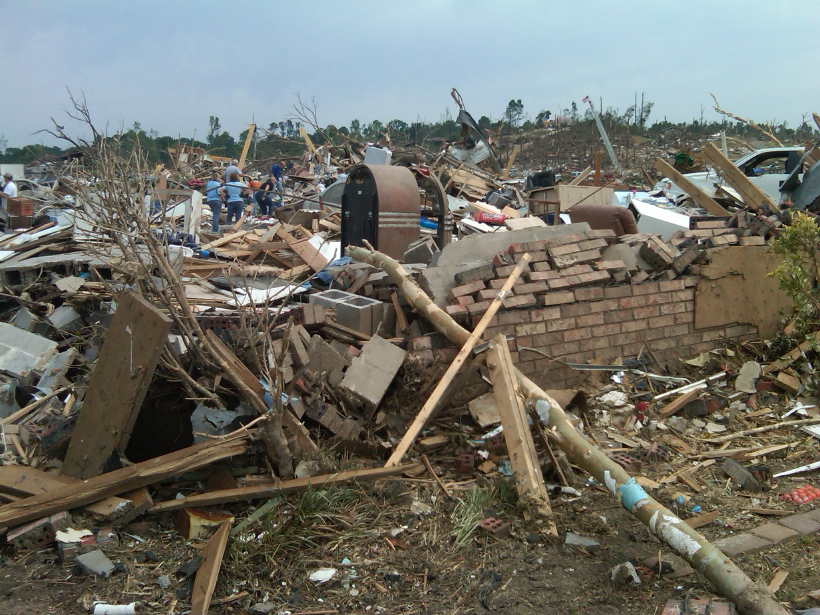When a dark, swirling funnel cloud dips toward the ground, people living in a U.S. region in and near the Great Plains popularly known as Tornado Alley know to move to a safe spot. Tornadoes can destroy concrete buildings and send railcars rolling, and these violent windstorms account for roughly 20% of natural hazard–related deaths in the United States.
Despite tornadoes’ danger, the correlations among the number of storm-related casualties, a twister’s energy, and the size of the population in its path are not well understood. Better understanding of those relationships could help scientists, policy makers, and emergency management personnel predict future tornado deaths and injuries based on trends in population growth and tornado activity. Now researchers have used a principle of economics to show that a tornado’s casualty count depends more strongly on the energy of the storm than on the size of the local population.
This study is “likely to spur conversation and additional research,” said Todd Moore, a physical geographer at Towson University in Towson, Md., not involved in the study. “It provides a framework that can be modified to include additional risk variables.”
Fear Becomes an Obsession
Tyler Fricker grew up hearing his father’s stories of the 1974 Xenia, Ohio, tornado that killed 33 people and injured more than 1000 others. Fricker, now a geographer at Florida State University in Tallahassee and the lead author of the new study, has also lived through a few tornadoes of his own. He explains his fascination with tornadoes as “fear becoming an obsession.”
“By understanding tornado behavior better…we get a deeper understanding of what may be causing the death and destruction we see in these storms.”
In the new research, he and his colleagues analyzed 872 casualty-causing tornadoes that swept through parts of the United States between 2007 and 2015. They defined “casualty” as a death or injury related to a storm. “By understanding tornado behavior better…we get a deeper understanding of what may be causing the death and destruction we see in these storms,” said Fricker.
The team borrowed a principle of economics known as elasticity to investigate how a tornado’s casualty toll scaled with its energy and the size of the nearby population. Elasticity is commonly used by economists to investigate how two measurements—for example, supply and demand—are related.
The researchers used National Weather Service data to determine the energy dissipated by a tornado. They calculated this energy as proportional to the area of a tornado’s path multiplied by its average wind speed raised to the third power. Knowing this quantity for each tornado allowed the team to uniformly define the intensity of each storm. The researchers then collected population measurements in roughly 1 × 1 kilometer squares for the path of each tornado using a database of world population maintained by Columbia University.
Predicting Casualties
Armed with these two measurements and the published casualty counts for each of the tornadoes in their sample, Fricker and his colleagues investigated how casualties scaled with storm energy and the size of the nearby population. The scientists found that storm energy was a better predictor of the number of storm-related injuries and deaths: Doubling the energy of a tornado resulted in 33% more casualties, but doubling the population of a tornado-prone area resulted in only 21% more casualties. These results, which the team reported last month in Geophysical Research Letters, can inform emergency planning, the team suggests.
“It’s hard to control the behavior of tornadoes.”
The relatively larger impact of tornado energy on casualties might be cause for concern, Fricker and his colleagues note. If climate change is triggering more powerful tornadoes, an idea that’s been suggested and debated, emergency managers might have to contend with larger casualty counts in the future. But scientists are by no means certain that larger tornadoes are imminent. “There is no doubt climate change is influencing hazards, but for tornadoes, we just simply don’t know to what extent yet,” said Stephen Strader, a geographer at Villanova University in Villanova, Pa., not involved in the study.
It is “far more likely” that the population will double in the future rather than the tornado energy, notes Victor Gensini, a meteorologist at the College of DuPage in Glen Ellyn, Ill., who was not involved in the study. Effective communication and good city planning might help reduce storm-related casualties, Fricker and colleagues suggest. “It’s hard to control the behavior of tornadoes, but it’s somewhat within our control to smartly advance how we organize cities and suburbs,” said Fricker.
Many More Factors
Of course, changes in storm energy and population can’t fully explain all variations in storm-related deaths or injuries. “There are also more factors that combine to determine a casualty, one of the most important being what type of structure a person is in when the tornado strikes,” said Gensini.
“You might have only 10 or 15 minutes to get to a safe spot.”
Fricker said he and his colleagues are looking forward to examining factors such as how a victim’s age, socioeconomic status, and race might correlate with vulnerability to harm from a tornado. “Maybe we’ll be able to profile communities more susceptible to casualties based on all of these other determinants,” said Fricker.
The team hopes that their findings will be useful to emergency personnel, who could target these most vulnerable populations when they spread information about tornado preparedness, for example. After all, “you might have only 10 or 15 minutes to get to a safe spot,” said Fricker.
—Katherine Kornei (email: [email protected]; @katherinekornei), Freelance Science Journalist
Citation:
Kornei, K. (2017), Tornado casualties depend more on storm energy than population, Eos, 98, https://doi.org/10.1029/2017EO073889. Published on 18 May 2017.
Text © 2017. The authors. CC BY-NC-ND 3.0
Except where otherwise noted, images are subject to copyright. Any reuse without express permission from the copyright owner is prohibited.

